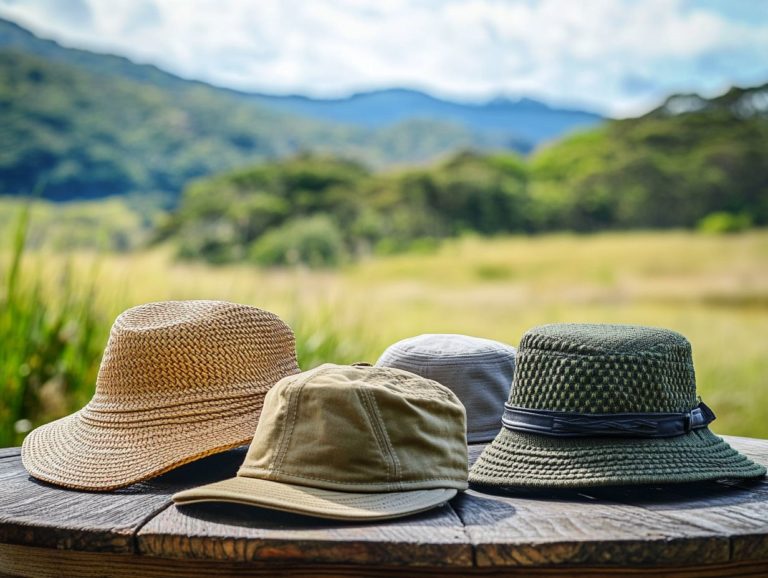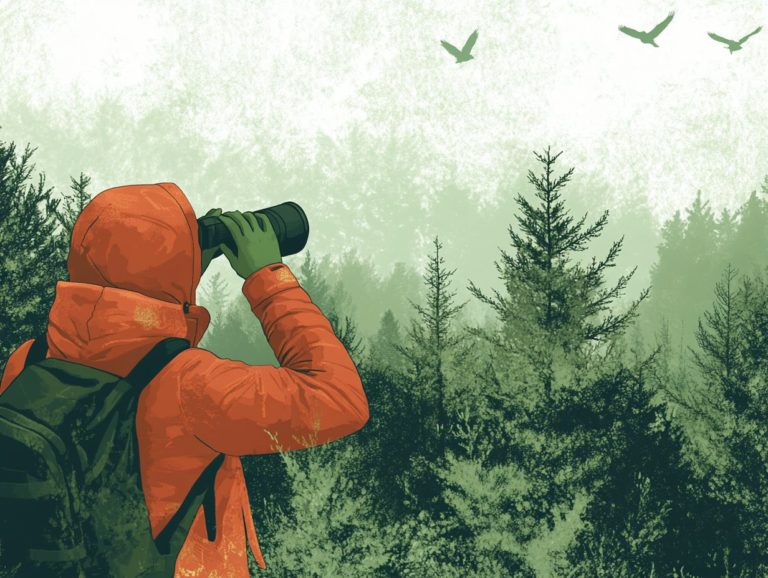How to Prepare for Bird Watching in Extreme Weather
Bird watching can be a thrilling adventure, yet extreme weather conditions can transform a simple outing into a formidable expedition.
Whether you re braving the biting chill of winter or enduring the sweltering heat of summer, grasping how different weather types affect bird behavior is essential for a rewarding experience.
This guide delves into the vital gear, safety tips, and prime locations for bird watching in extreme conditions. You ll discover resilient bird species you might encounter during your birding trips, especially those that thrive in extreme conditions.
Get ready to dive into the exciting world of bird watching!
Contents
- Key Takeaways:
- Understanding Extreme Weather Conditions for Bird Watching
- Essential Gear for Extreme Weather Bird Watching
- Preparing for Extreme Weather Conditions
- Choosing the Right Location for Extreme Weather Bird Watching
- Common Birds to Look for in Extreme Weather
- Frequently Asked Questions
- What should I wear for bird watching in extreme weather?
- What type of footwear should I bring for bird watching in extreme weather?
- How should I protect my equipment from extreme weather while bird watching?
- What are some essential items to bring for bird watching in extreme weather?
- How should I plan my route for bird watching in extreme weather?
- What precautions should I take while bird watching in extreme weather?
Key Takeaways:

- Wear appropriate clothing and gear to stay safe and comfortable in extreme weather conditions while bird watching.
- Choose the right location for extreme weather bird watching by considering factors such as terrain, accessibility, and bird species.
- Prepare for extreme weather by understanding the different types of weather conditions and their impact, and following key birdwatching tips for staying safe and comfortable.
Understanding Extreme Weather Conditions for Bird Watching
Understanding extreme weather conditions is essential for you as a birdwatching enthusiast, as these factors directly influence bird behavior, habitat availability, and navigating bird watching gear options for all seasons.
Each season winter, spring, summer, and autumn presents its own set of unique challenges, including high winds, rain, and ice, all of which shape your birding experience.
Adapt to changing weather conditions to see more birds and have a successful outing. Consider how temperature fluctuations, wind speed, and precipitation levels significantly affect the types of species you can spot across different habitats, from coastal areas to inland regions.
Types of Extreme Weather and Their Impact
Extreme weather conditions such as strong winds, heavy rain, ice, and frigid temperatures significantly influence bird species and their migratory behavior.
These elements can disrupt established migratory routes, compelling some birds to seek alternative paths or even delaying their migration altogether. For instance, when coastal storms create dangerous conditions, gulls may find themselves pushed inland in search of shelter and food.
Similarly, ducks face challenges during cold snaps that freeze their usual habitats, often leading them to migrate further south earlier than anticipated.
Raptors, too, encounter difficulties; strong winds can affect their soaring abilities, ultimately impacting their hunting success. As a birdwatcher, closely monitor weather forecasts, adjust your timings for optimal viewing, and explore new locations that may be temporarily bustling with these displaced species.
Essential Gear for Extreme Weather Bird Watching
Having the right gear is absolutely essential for birdwatching in extreme weather conditions; it not only enhances your comfort but also significantly boosts your chances of successfully observing wildlife. For those looking to improve their experience, preparing for a bird photography outing can make all the difference.
Imagine donning suitable clothing like thermal clothing, which is designed to trap body heat, and water-resistant outer layers that shields you from the relentless rain, biting cold, and fierce wind, especially during winter weather.
Quality binoculars become your best friend, elevating your observation experience as you spot elusive species from a distance, transforming your quest into a rewarding adventure.
Plus, when you incorporate photography equipment, you can capture breathtaking moments against stunning natural backdrops, enriching your birding trips and making memories that last a lifetime.
Recommended Clothing and Equipment

For extreme weather birdwatching, invest in durable, weather-resistant outerwear, insulated clothing, and high-quality binoculars for the best visibility. Additionally, consider checking out this guide on how to prepare for a bird watching trip to ensure you’re fully equipped.
Layering is your best friend. Wear a base layer that keeps you dry and a breathable fleece for warmth. Don’t forget sturdy, waterproof footwear to navigate various terrains.
A wide-brimmed hat shields you from the sun and rain. Carry a reliable field guide to enhance your experience and learn about different species!
A comfortable backpack is essential. It gives you quick access to snacks and hydration for a productive outing.
Preparing for Extreme Weather Conditions
Preparing for extreme weather is vital for your safety and comfort. Consider the latest forecasts, potential hazards, and the species you want to see.
Plan ahead to turn challenging conditions into a rewarding outdoor experience!
Key Tips for Staying Safe and Comfortable
To enjoy birdwatching in extreme weather, embrace strategies for tackling nature’s challenges.
Choose locations that offer shelter from wind and rain. Carry enough water to stay hydrated, especially on hot days.
Keep an eye on weather changes. Being aware of storms or temperature shifts allows you to adjust your plans in advance.
Layer your clothing for comfort and protection. This way, your birdwatching enjoyment won’t be interrupted, no matter the weather.
Choosing the Right Location for Extreme Weather Bird Watching
Selecting the right spot for birdwatching requires careful thought. Look at habitat types, weather conditions, and the species you want to see.
Locations change with seasons. For example, reservoirs attract waterfowl, while coastal areas may be full of seabirds like gulls and migratory raptors.
Understanding these factors helps make your birdwatching experience even better!
Factors to Consider and Popular Destinations

When choosing a birdwatching destination, consider habitat availability, weather, and the bird species you wish to see.
These factors affect bird activity. For instance, some birds thrive in wetlands during migration, while others prefer coastlines in warmer months.
Check out hotspots like the Everglades or the Pacific Northwest for diverse habitats and a chance to see everything from shorebirds to majestic raptors!
Weather conditions can affect migratory patterns and nesting behaviors, shaping your birdwatching adventure.
Common Birds to Look for in Extreme Weather
Certain common birds possess a great skill in surviving extreme weather conditions, offering birdwatchers remarkable opportunities to observe their behaviors across the seasons.
Imagine raptors gracefully soaring on thermals during winter or waders diligently foraging in coastal mudflats come autumn. By understanding which species flourish under varying conditions, you can elevate your birdwatching experience to new heights.
Migrants like Pied Wagtail and Meadow Pipit become increasingly visible in distinct habitats as the weather shifts, making every outing a chance to witness nature s dynamic tapestry.
Species That Thrive in Extreme Conditions
Species that thrive in extreme weather conditions encompass an array of raptors, waterfowl, and seabirds, each exhibiting remarkable adaptations that allow them to not only survive but flourish.
Take the peregrine falcon, for instance. Its extraordinary speed and agility make it a masterful hunter, even in the harshest environments. The common eider, a waterfowl with thick insulating feathers, is often seen resting on icy waters, showcasing its resilience against frigid temperatures.
Let s not forget the wandering albatross, renowned for its impressive wingspan, effortlessly gliding over tumultuous ocean waves and riding the winds with unmatched grace.
For birdwatching enthusiasts like yourself, these species bring excitement to every birdwatching adventure, especially during migration seasons or in protected coastal areas. Here, you can witness their unique behaviors and adaptations in all their glory, making for an unforgettable observation experience.
In addition to observing raptors, gulls, and ducks, the varied habitats of coastal regions during spring and autumn provide ideal conditions for birdwatching.
Frequently Asked Questions
What should I wear for bird watching in extreme weather?

It is important to dress in layers when preparing for bird watching in extreme weather. This allows you to adjust your clothing as temperatures and weather conditions change, whether it’s winter weather or high winds of early spring. For more tips on attire, consider how to stay comfortable while bird watching and wear waterproof and windproof outer layers to protect yourself from rain, wind, and snow.
What type of footwear should I bring for bird watching in extreme weather?
When bird watching in extreme weather, it is best to wear sturdy and waterproof hiking boots. These provide traction and keep your feet dry and warm. Bring an extra pair of socks in case your feet get wet, especially during cold winter days.
How should I protect my equipment from extreme weather while bird watching?
Be sure to bring a waterproof cover or case for your camera, binoculars, and any other equipment you may be using. This protects them from rain, snow, and moisture. Keep them in a padded bag to prevent damage from bumps or falls. Investing in high-quality binoculars those that provide clarity and durability will enhance your observation experience, especially when tracking waterfowl and seabirds.
What are some essential items to bring for bird watching in extreme weather?
In addition to appropriate clothing and footwear, it is important to bring along some other essential items:
- Sunscreen
- Insect repellent
- A hat
- Gloves
- A thermos with a warm beverage
- Bird feeders for attracting more species
How should I plan my route for bird watching in extreme weather?
When planning your route, check the weather forecast beforehand and choose a location that provides shelter from extreme conditions, such as reservoirs or coastal areas shielded from high winds. To enhance your birdwatching experience, consider using top birding binoculars for extreme weather and have a backup plan in case the weather becomes too severe to continue in your original location.
What precautions should I take while bird watching in extreme weather?
In addition to dressing appropriately and protecting your equipment, take safety precautions while bird watching in extreme weather. Stay hydrated, take breaks to warm up, and avoid areas with strong winds or hazardous conditions. For more specific guidance, check out these tips for photographing birds in bad weather, particularly during migration periods when bird activity increases.
Prepare for your birdwatching adventure and enjoy nature’s beauty like never before!






